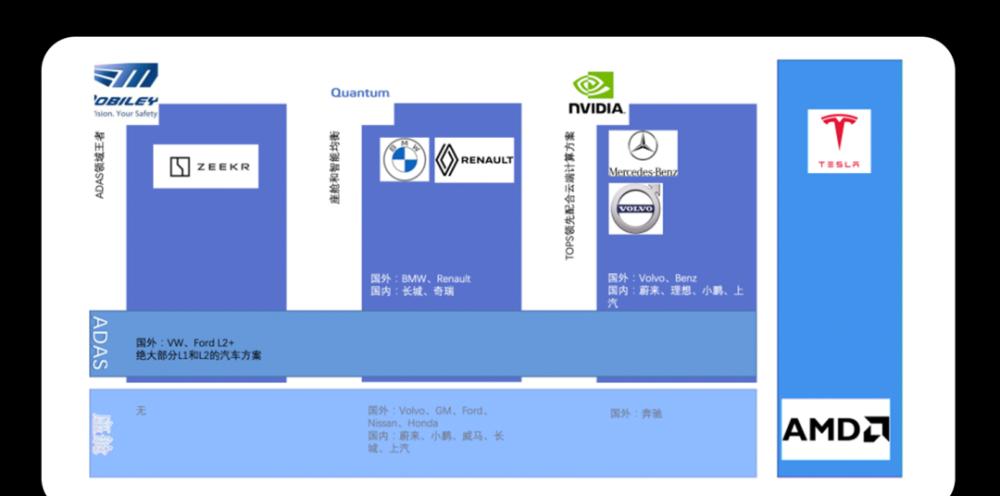CES 2022 brings a lot of interesting things, the main highlight of this stage is to see the two parts of the intelligent cockpit and intelligent driving, and these two areas have now formed a more interesting pattern.
● Smart cockpit
Qualcomm is the leading supplier, and through this bridgehead it is heading towards smart driving, also known as Digital Chassis.
● Intelligent driving
The core essence of Mobileye is to develop a proprietary scheme for algorithms and chip replacements, which seems to be somewhat outdated under the current competition; it is mainly Nvidia that currently dominates this field.
After opening the TOPS war, the server-side computing requirements were put forward, that is to say, it provided car companies with a collaborative development path similar to Tesla's edge computing and cloud computing; at the same time, Nvidia was still doing some high-end cockpit solutions.

Figure 1: Autonomous driving pattern around foreign chips and solutions
Part 1
CES 2022 home programs
●Mobileye
After Intel wants to split Mobileye, it can actually see the sense of crisis. The next-generation L4 autonomous driving SoC released by CES2022, the EyeQ Ultra of the 5nm process, is to be launched in 2025, with the goal of achieving L4 autonomous driving (the basis for Robotaxi and other fixed-area vehicles, operating in a known and well-defined area under limited weather conditions).
Mobileye's previous L4 hardware scheme is composed of 6-8 EyeQ chips, that is, SoCs that are cheap enough and have room for evolution in the mass production market, and the EyeQ Ultra is taken out, connecting multiple cameras and other perception sensors, and the official performance data is 176TOPS. From Mobileye's perspective, vision-based autonomous driving is a relatively mature area of technology that can build ASICs, using highly specialized fixed functions (limited flexibility).
Different types of cores inside EyeQ Ultra (the next 4 groups of cores contain Mobileye's "proprietary accelerator") include 12 RISC-V CPU cores, Arm GPUs, Arm DSPs, SIMD cores, VLIW cores CGRA (Coarse grained reconfigurable array) cores, and Deep Learning cores.
Figure 2. Mobileye's EyeQ ULTRA chip
Mobileye's starting point is around low cost, low power consumption, from a logical point of view, the main competitor of this chip is Nvidia's Atlan SoC (which will be launched in the same period in 2025), Atlan only SoC throughput is more than 1000 TOPS, Nvidia high deep learning throughput, for automotive companies is indeed very attractive.
The difference in TOPS throughput simply reflects the difference in design philosophy between the two, Nvidia's software-defined approach and Mobileye's specific task accelerator are two different paths, and it's hard to decide which approach will produce better results.
Mobileye's approach is based on the accumulated technical direction and related self-driving algorithms, while Nvidia opens the door to more flexible methods in the future (car companies need more powerful weapons to catch up).
● Nvidia
The release of CES 2022 NVIDIA is mainly based on platform considerations, Drive Hyperion 8 is around 9 radars, 12 ultrasonic, 1 front radar, more than 12 cameras (priced to 10,000 US dollars of sensors), 2022 to start production. The first to use NVIDIA's self-driving platform in this wave are Chinese car companies, Xiaopeng, Weilai, Ideal, R Cars, Zhiji and Polestar.
In terms of software, Nvidia made a Drive Sim for generating driving scenarios to support development, whether it is a truck or a passenger car, it needs to have a huge basic background facility calculation to support (L5 needs 25,000 GPUs), this winner is still Nvidia, accounting for the majority of the market - this piece is also led by Tesla technology route, NVIDIA with everyone to quickly follow.
Figure 3:NVIDIA began to tell the story of the platform and the backstage
● Qualcomm
This time Qualcomm actually told the story of this overall automotive product line, including:
◎ Software service platform Snapdragon Car-to-Cloud
Enables automakers to develop new revenue streams. Snapdragon Auto Connectivity 4G LTE, 5G, cellular vehicle networking (C-V2X), wifi, Bluetooth and satellite positioning can network vehicles.
Digital cockpit Snapdragon Cockpit
Including infotainment, instrumentation and visualization - in this, basically around the Android collocation to do, foreign Volvo, Renault, Honda, GM, Ford and FCA is the use of the original Android Android Automotive, several domestic car manufacturing companies (Weilai, Xiaopeng, Weima, Great Wall, etc.) play their own Android.
The digital chassis Snapdragon Ride includes the Arriver Vision System, qualcomm uses the Arriver Vision stack developed in collaboration with Veoneer, and then directly buys the Arriver business unit during the Veoneer sale process, and then forms the basis of the digital chassis.
Qualcomm's approach, or around openness, this Snapdragon Ride vision system supports multiple cameras, including a higher resolution 8 MP camera, with a modular design, and the car company and Tier 1 can use Qualcomm's full stack or integrate the vision stack with the drive strategy stack developed elsewhere, integrating a variety of other components, including parking assistance, driver monitoring, and map crowdsourcing.
Figure 4.Qualcomm has set the platform,
Tier 1's role in it is slowly getting smaller
The mass production time of this system is about 2023-24, the basic time point is similar to the previous ME system, this time point is probably that General Motors will become the first model to use snapdragon Ride ADAS processors and models, 2023 Ultra Cruise will be used in urban roads, starting from 2025, BMW's next generation of autonomous driving system will also use the Snapdragon Ride platform, followed by Renault in 2025. Adopt the entire Qualcomm Snapdragon digital chassis platform.
Summary: The full promotion of autonomous driving chip manufacturers has actually received strong support from automobile companies, and we can also see the demand for core support for the underlying hardware after automotive companies build their own autonomous driving software teams. With the gradual start of car companies, this soul is actually in their own hands is indeed more appropriate, the domestic automatic driving to do independent branches, must jump after the two.